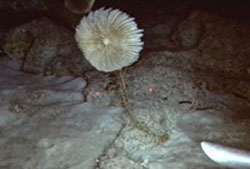
The most comprehensive climate model to date of the continental United States predicts more extreme temperatures throughout the country and more extreme precipitation along the Gulf Coast, in the Pacific Northwest and east of the Mississippi.
The climate model, run on supercomputers at Purdue University, takes into account a large number of factors that have been incompletely incorporated in past studies, such as the effects of snow reflecting solar energy back into space and of
The ice ages made massive changes to the Earth’s landscape. But what was happening below the ice in the oceans?
Research by marine scientists reveals that it was a time of mass destruction as whole communities of animals were wiped out by ice sheets scouring the sea floor.
In the past it has been thought that these ecosystems somehow dodged extinction by recolonising from nearby habitats that escaped obliteration. But researchers at the National Oceanography Centre,
The retreat of coastlines due to rising sea levels may be accelerated by wildfires, a Duke University researcher has discovered. In the absence of such fires, forests can slow the encroachment, he found. At such fire scenes, though, finger-like patches of marshlands can extend into former forest by as much as several hundred yards. The result is a “punctuated” near-shoreline landscape, the scientist said. Such punctuated advance of the sea is in sharp contrast to the widespread belief that coastal

With their long stalks and feathery arms, marine animals known as sea lilies look a lot like their garden-variety namesakes. Perhaps because of that resemblance, scientists had always assumed that sea lilies stayed rooted instead of moving around like their stalkless relatives, the feather stars.
But videos taken from a submersible research vessel at a depth of 430 meters (1410 feet) near Grand Bahama Island reveal that some sea lilies can creep along the ocean floor, apparently
A long time ago, people inhabiting settlements at the boarder of Dykoye Pole (Wild Field) used to bury empty jugs into the ground: if they started buzzing this meant that a cavalry detachment was galloping across the steppe and it was time to escape to the outpost from the foray. Specialists of the Institute of Physics of the Earth, Russian Academy of Sciences, suggest a similar way for tracking oncoming natural disasters like earthquakes or catastrophic landslides.
“The main task of the

Storms will dump heavier rain and snow around the world as Earth’s climate warms over the coming century, according to several leading computer models. Now a study by scientists at the National Center for Atmospheric Research (NCAR) explains how and where warmer oceans and atmosphere will produce more intense precipitation. The findings recently appeared in Geophysical Research Letters, a publication of the American Geophysical Union.
The greatest increases will occur over la